
How to make peach leather
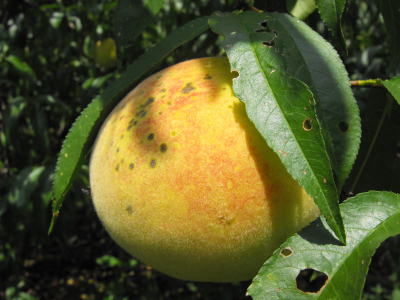 Step
1: Call up Mom.
There's a knack to cutting up wormy fruit, and chances are your
maternal helper will make the work go three times as fast. Bribe
her with less wormy peaches and other garden produce.
Step
1: Call up Mom.
There's a knack to cutting up wormy fruit, and chances are your
maternal helper will make the work go three times as fast. Bribe
her with less wormy peaches and other garden produce.
Step
2: Prepare the peaches.
Unless you bought your peaches from a commerical orchard, chances are
they need some bad spots cut out. Our peaches are the worst case
scenario since our oriental
fruit moth infestation
means that over half the fruits had rotten,
wormy centers. The quick and easy way to deal with troubled fruit
is to cut them in half and scoop out the rotten centers with a
spoon. Slice off the skin last in this case, or first if your
peaches are pristine.
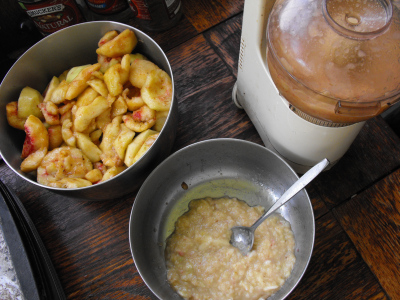 Step 3: Puree the raw peaches in a
food processor.
Step 3: Puree the raw peaches in a
food processor.
Step
4: Add honey to
taste. Honey gives the finished leather pliancy and helps
preserve the peach puree as
it dries. We added almost a cup of honey to about a gallon of
fruit puree --- use your own judgement here.
Step
5: Pour the puree and honey
mixture onto cookie sheets. The official method of
making
fruit leather involves spreading your puree on skins of saran wrap, but
we don't 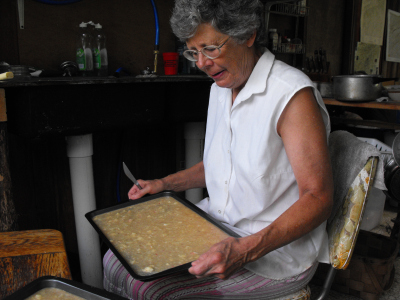 keep that kind of disposable
in the house. Cookie sheets
work fine as long as you don't mind your finished leather
getting bent
out of shape for storage.
keep that kind of disposable
in the house. Cookie sheets
work fine as long as you don't mind your finished leather
getting bent
out of shape for storage.
Step
6: Spread the puree to about 1/8
inch thick.
At first, we tried spreading the peach mush
with spoons and butter knives, then Mom had the great idea of just
jiggling the pan. The moist peach mixture quickly settled out
across the entire surface.
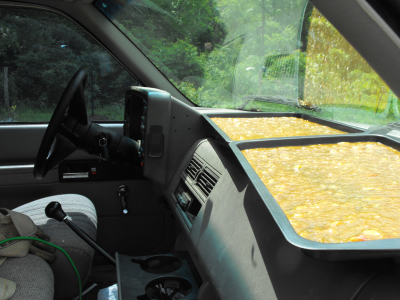 Step 7: Dry the fruit leather as quickly as
possible.
We haven't built our solar
dehydrator yet, so
last time I dried our fruit leather by moving it between our
east-facing sunny window (in the morning) and our west-facing sunny
window (in the afternoon.) Mom had the great idea of drying the
leather inside Joey's truck, which seems to be working even
better. You need hot temperatures around 100 F or higher to dry
the leather before it ferments and molds. Maximum drying time
should not exceed two and a half days.
Step 7: Dry the fruit leather as quickly as
possible.
We haven't built our solar
dehydrator yet, so
last time I dried our fruit leather by moving it between our
east-facing sunny window (in the morning) and our west-facing sunny
window (in the afternoon.) Mom had the great idea of drying the
leather inside Joey's truck, which seems to be working even
better. You need hot temperatures around 100 F or higher to dry
the leather before it ferments and molds. Maximum drying time
should not exceed two and a half days.
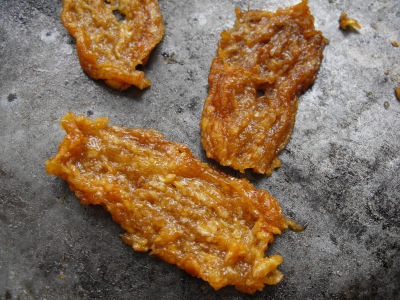 Step 8: Scrape the fruit leather off
the trays with a spatula. Depending on how much
moisture is left in your leather, it may peel off, or rumple up as
shown in my
pictures. I prefer the slightly wetter leather even though it's
less pretty.
Step 8: Scrape the fruit leather off
the trays with a spatula. Depending on how much
moisture is left in your leather, it may peel off, or rumple up as
shown in my
pictures. I prefer the slightly wetter leather even though it's
less pretty.
Step
9: Store your peach leather.
Fruit leather will last at room temperature for about a month, but I'm
planning to use the peaches as a supplement to our winter fruit.
In the freezer, fruit leather should last about a year.
Want more in-depth information? Browse through our books.
Or explore more posts by date or by subject.
About us: Anna Hess and Mark Hamilton spent over a decade living self-sufficiently in the mountains of Virginia before moving north to start over from scratch in the foothills of Ohio. They've experimented with permaculture, no-till gardening, trailersteading, home-based microbusinesses and much more, writing about their adventures in both blogs and books.
Want to be notified when new comments are posted on this page? Click on the RSS button after you add a comment to subscribe to the comment feed, or simply check the box beside "email replies to me" while writing your comment.

If you boiled the pureeded peaches for a short while to kill bacteria and maybe deactivate spores before decanting them onto the cookie sheets, the drying would go faster and the end product might last longer.
BTW, you might want to look at silicone bakeware. Doesn't stick and is easy to clean. Lasts a long time and is chemically inert under normal circumstances.
I'm sure boiling would help, but the whole reason I'm making fruit leather is to save the fresh fruit taste. I've got some sort of hangup --- cooked fruit doesn't make me as happy as fresh fruit. So far, fruit leather is the only kind of preserved fruit that pushes my fresh fruit buttons.
So far, fruit leather is the only kind of preserved fruit that pushes my fresh fruit buttons.
Mark got me some non-stick cookie sheets for fruit leather part 2, and it does let me peel the leather off a little better. Still, at the moist stage I like to stop drying at, I have to use a spatula.